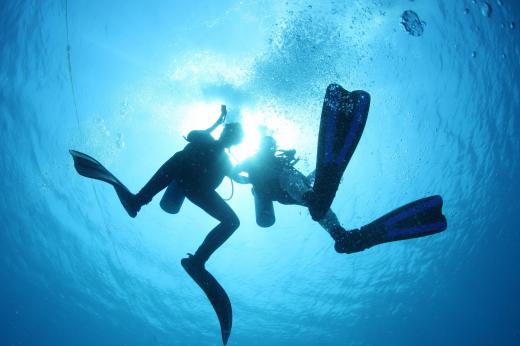At Sports&Hobbies, we're committed to delivering accurate, trustworthy information. Our expert-authored content is rigorously fact-checked and sourced from credible authorities. Discover how we uphold the highest standards in providing you with reliable knowledge.
What is a Wetsuit?
Diving suits have been around for a long time now. Over the years, various types of diving suits have been developed for use in water recreation, research, and professional diving. One of the more popular types of the diving suit is the wetsuit. Here are some distinguishing traits of wetsuits, as well as a few examples of when a wetsuit would be the appropriate kind of diving suit to wear.
Wetsuits are worn when engaging in activities that involve water with a temperature that is neither extremely cold nor extremely hot. A good range of water temperature for wetsuit use is around 50 degrees Fahrenheit to eighty degrees Fahrenheit.

Made of a light material such as neoprene, the wetsuit actually does let a little water into the suit. The water is allowed to circulate between the skin of the diver and the inside layer. As a result, the trapped water gradually warms up to body temperature and can help keep the diver comfortable during the diving process. While the wetsuit does need to be form fitting, it is important that it not be too tight. This allows the warmed water to remain in place for the duration of the dive, especially important in recreational scuba diving, as the material will compress somewhat as the diver goes deeper.

The wetsuit is really meant as a comfortable garment to be used for water sports, either recreational or professional. Often, surfers will opt for the shorter version of the wetsuit, which provides cover for the torso, along with short sleeves and legs. This same type of wetsuit also works well with boating, water skiing, and swimming. A longer version of the wetsuit completely covers the body, including long sleeves and legs. This long version basically leaves the neck, head, hands and feet exposed. With more protection for the body, the longer version may be used in cool weather conditions, as well as in light diving in warm waters.

While many wetsuits are very light and easy to take on and off, suits with a greater thickness on the arms may be a bit more cumbersome. Some of the thicker wetsuits will even be somewhat stiff, which makes them unsuited for a number of recreational water sports, although they are ideal for shallow diving in cooler waters. When looking at a wetsuit, it is important to note the torso thickness as well as the limb thickness of the suit. A suit with a higher degree of thickness will be stiffer, while a wetsuit with a lower degree of thickness will be much more supple and flexible.
Wetsuits are relatively inexpensive and come in sizes and styles appropriate for children, men, and women. Typically, it is easy to purchase a wetsuit at sporting goods stores, as well at many retail outlets that specialize in recreational wear for the beach. With their unique properties of buoyancy and body temperature protection while still allowing for free movement of the arms and legs, the wetsuit will no doubt be used in many water sports for many years to come.
AS FEATURED ON:
AS FEATURED ON:













Discuss this Article
Post your comments